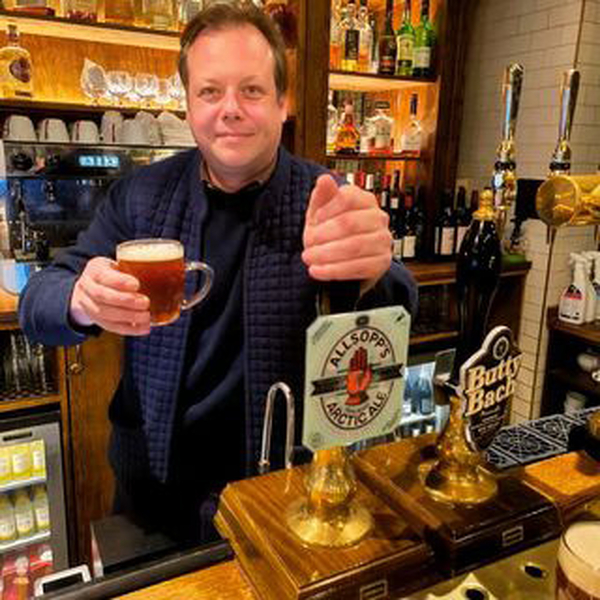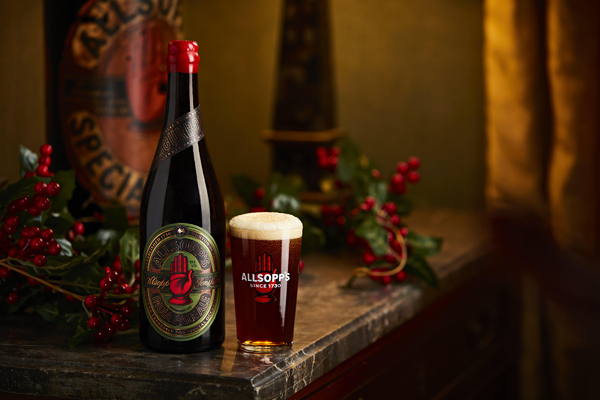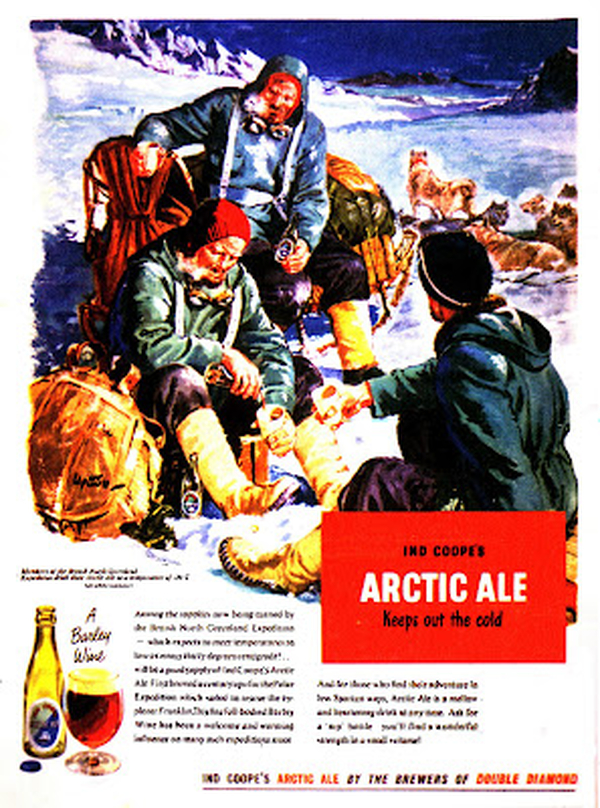Historic Burton ales restored by grandson
Added: Monday, December 4th 2023

A stroke of good luck enabled Jamie Allsopp to restore one of the most famous names in British brewing along with its leading beers Pale Ale and IPA.
Jamie is the seven times great grandson of Samuel Allsopp, a leading brewer in Burton-on-Trent in the 19th century. Allsopp, along with such other celebrated brewers as Bass and Worthington, harnessed the mineral-rich waters of the Trent Valley to develop new pale ales that revolutionised brewing both in Britain and on a world scale.
The good luck came when veteran brewer Steve Holt, who runs the Kirkstall Brewery in Leeds and is an avid collector of breweriana, bought a ledger in an auction that contained Allsopp’s recipes from the 19th century.
This was manna from heaven for Jamie Allsopp, who is the cousin of TV presenter Kirstie Allsopp. He worked as a hedge fund manager in the City of London and he used the money he made there to restore the family tradition with Samuel Allsopp & Sons in 2020.
He took the brewing ledger, which dates from 1934, to Jim Applebee, an experienced brewer who had worked at the Heritage Brewery in Burton. With further advice from Steve Holt, interpretations of Allsopp’s Pale Ale and IPA were brewed. They were made at first in Sheffield but they have since been transferred to Kirkstall.
“But we’re going back to Burton,” Jamie says emphatically. “I’m in discussion with the local council to find a suitable site. It will probably take two years before we’re ready to brew.”
Brewing the beers in Burton will restore the heritage of the Allsopps, though the brewery began in 1742 with the name of Benjamin Wilson. His son, also Benjamin, turned it into the biggest and most influential brewery in the town.
Wilson Jnr had no children. He employed his nephew Samuel Allsopp and sold the business to him in 1807 and it became Samuel Allsopp & Sons in 1822.
In that fateful year, Allsopp was invited to dine at the London home of Campbell Majoribanks, chairman of the East India Company that exercised near monopoly control over trade in the sub-continent. He urged Allsopp to send beer to India but stressed it should be a paler and more refreshing one than the dark milds, porters and stouts sent there.
Marjoribanks presented Allsopp with bottles of pale beer brewed by Hodgson’s Brewery in East London and exported to India. Hodgson had angered the East India Company by not paying his bills and Allsopp was encouraged to work with the EIC to replace the London brewer.
Samuel Allsopp was keen to find new markets for his beer. In common with all the Burton brewers, his lucrative trade in Russia and the Baltic States with nut brown Burton Ale had collapsed due to the French under Napoleon Bonaparte blockading the Baltic ports to British exports.
Allsopp took samples of Hodgson’s beer back to Burton where he presented them to his head brewer, Job Goodhead. He spat the beer out, affronted by its bitterness but he said that, by preparing his malt to a paler colour, he could produce a similar beer to Hodgson’s. In fact, the Trent water, rich in gypsum and magnesium, enhanced both the malt and hop character of his beer and soon Allsopp’s pale ale was outselling Hodgson’s in India.
The success of India Pale Ale was brief. By the end of the 19th century both American and German brewers were supplying India and other British colonies with their new lager beers. Served ice cold, they suited hot climates better than ale. Allsopp and the other Burton brewers responded by attacking the domestic market with lower strength pale ales.

In 1934 Allsopp merged with its next-door neighbour to form Ind Coope & Allsopp. The Allsopp influence declined as the new company became best known for the Ind Coope beer Double Diamond. This was originally an IPA but post World War Two it became a leading brand in the new style keg beer market.
In the 1960s Ind Coope & Allsopp joined with Ansells of Birmingham and Tetley of Leeds to form Allied Breweries. This brewing and pub-owning giant went through several ownerships and eventually in 1991 it became part of a joint venture called Carlsberg-Tetley. Brewing ceased in Burton.
The Allsopps had stood aside from managing the company in 1911. Now Jamie Allsopp is restoring not only the key beers brewed in Burton but also the good name of the family.
As well as Pale Ale (4.4%) and IPA (5%) he’s also resurrected Allsopp’s Pilsner (4.6%) first brewed in the 1890s. It was not only ahead of its time but also ahead of drinkers’ tastes and was a spectacular failure. Times have changed and Pilsner is now part of Jamie’s regular portfolio.
He uses a blend of Chevallier and Maris Otter malts with Fuggles and Goldings hops for Pale Ale and IPA. The lager is brewed with Pils and Munich malts and is hopped with Goldings and Hallertau Hersbrucker varieties.
Crucially, Jamie was able to get the original Allsopp’s yeasts from the NCYC – the National Collection of Yeast Cultures -- in Norwich. This resource invites all brewers to deposit samples of their cultures. As yeast retains the flavours and character of individual beers, it’s imperative they are used to recreate revived beers such as Allsopp’s.
Jamie was also able to win back the famous Allsopp’s Red Hand trademark that was first registered in 1876, the same year that Burton rival Bass registered its red triangle trademark. The Red Hand is not connected to the historic symbol for Ulster but is an ancient way of indicating that something special has been made: it was used by London coffee houses in the 18th century.
The Allsopp’s trademark had been acquired by the Scottish brewer BrewDog for possible use but it was willing to pass it to Jamie. Similarly, Carlsberg handed over the rights to Allsopp’s brands.
The revived beers have gone down well and IPA won a prize in its class in the annual Burton Ale Trail competition.
In December 2023 Jamie unveiled a Special Release version of IPA (pictured) with a redoubtable strength of 10% that has been aged in both whisky and Bourbon oak casks. It celebrates the revival of Allsopp’s beers and will be used to toast their return to Burton.

The beer that came in from the cold
In the autumn of 2010 a remarkable find was made in the cellars of the former Allsopp’s Brewery across the road from Burton train station. The new owner of the buildings had found a collection of old bottles of beer covered in dust and cobwebs. On close inspection, the bottles were identified as Allsopp’s Arctic Ale.
The beer has both a fascinating and tragic history. In 1845 Rear-Admiral Sir John Franklin led an expedition to the Canadian Arctic in an attempt to chart and navigate the North West Passage from the Atlantic to the Pacific. The mission failed, the ships foundered and the crew perished.
Queen Victoria demanded that efforts be made to find the remains of the expedition. Five ships were commanded by Sir Edward Belcher and the Admiralty asked Burton brewers to make a strong beer that would contain high levels of vitamin B to prevent the seamen getting scurvy.
The contract was awarded to Allsopp’s but Belcher’s mission in 1851 failed. In 1857 and 1875 further searches were made without success and it was bottles from the final mission that were found in the Allsopp’s cellars.
In February 2011 a group of beer lovers and writers met at the National Brewery Centre in Burton where Steve Wellington from the William Worthington Brewery carefully withdrew the cork from one of the bottles. The cork started to disintegrate and Steve warned his audience that the beer may have oxidised.
But it proved to be in fine drinkable form. It was thought to be around 11% alcohol and it was dark amber in colour with a complex aroma of chocolate, cocoa, molasses and vinous fruit. The palate offered creamy malt, sweet fruit and further notes of chocolate and cocoa. The finish was bittersweet with dark fruits, rich toasted grain, more notes of chocolate and cocoa and a slight hint of spicy hops.
The tasters were unanimous that, 136 years old, it was a highly drinkable beer.
The beer was sold commercially in small nip bottles but it was withdrawn in the 1970s. It's now being brewed again by Jamie Allsopp. It's currently on draught and will be available in bottle in 2024.








